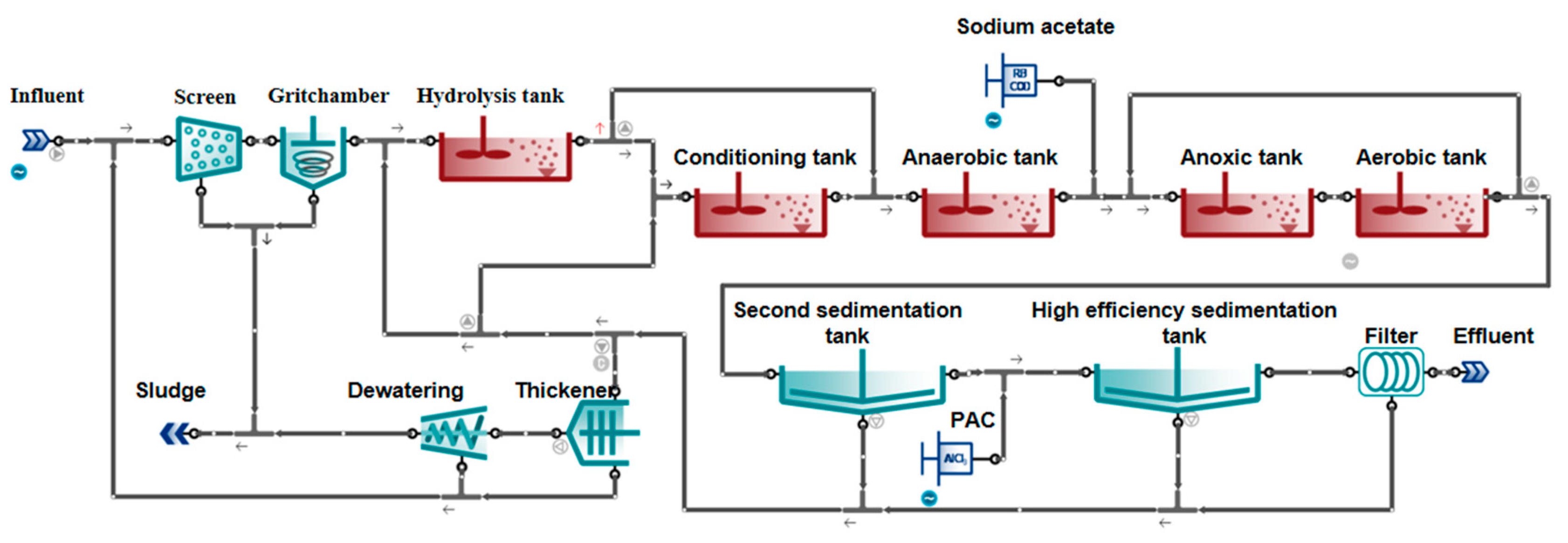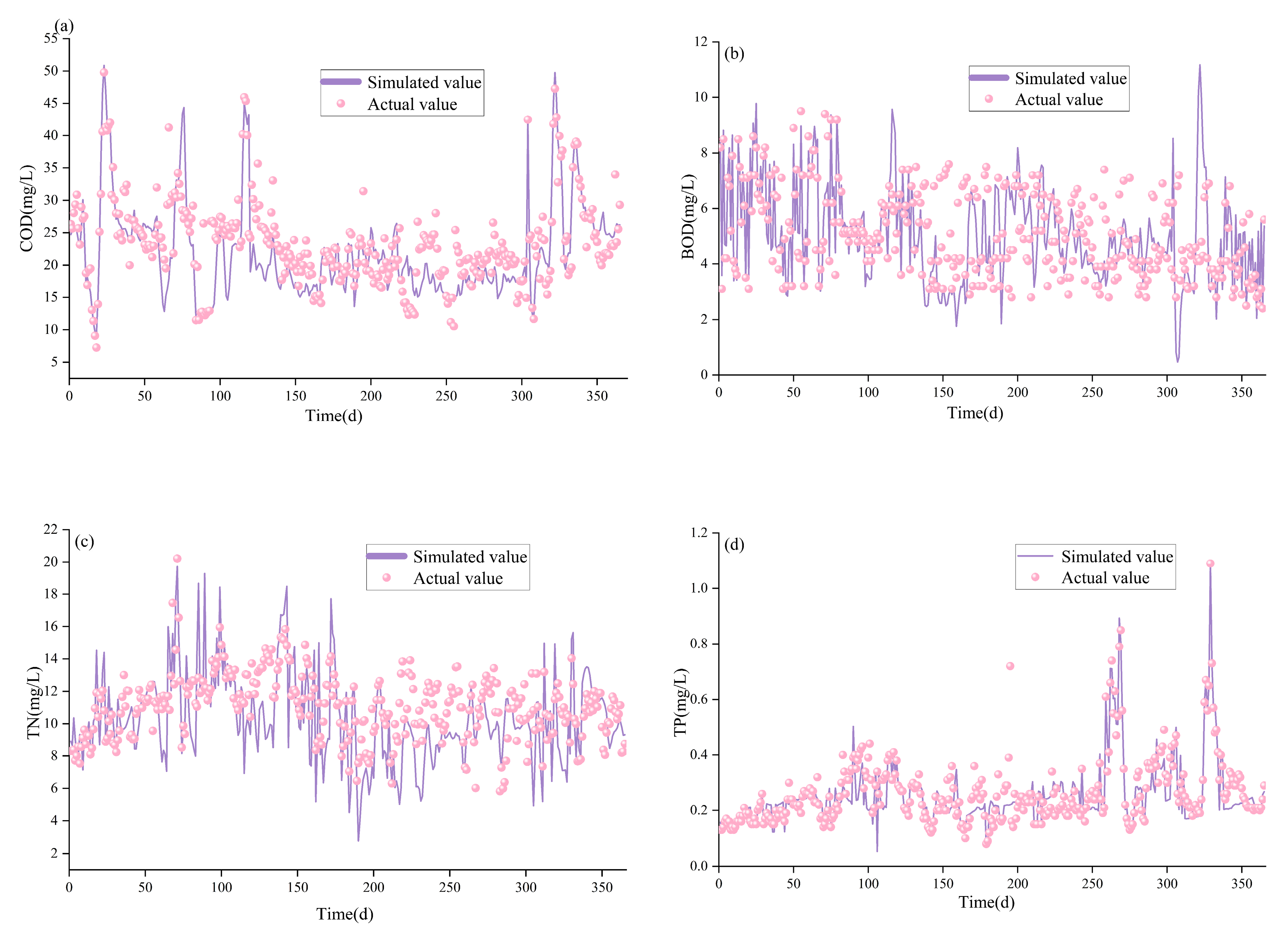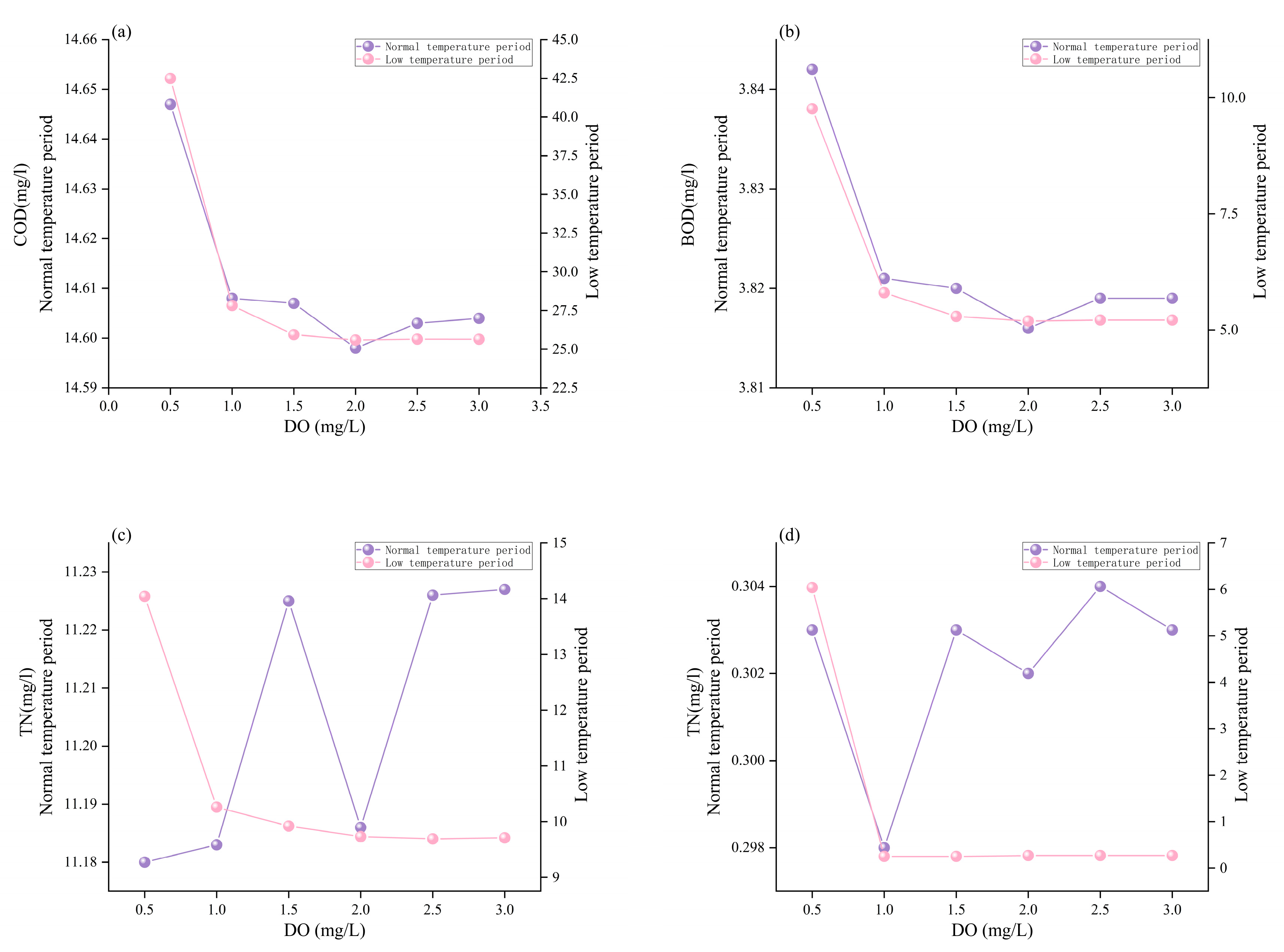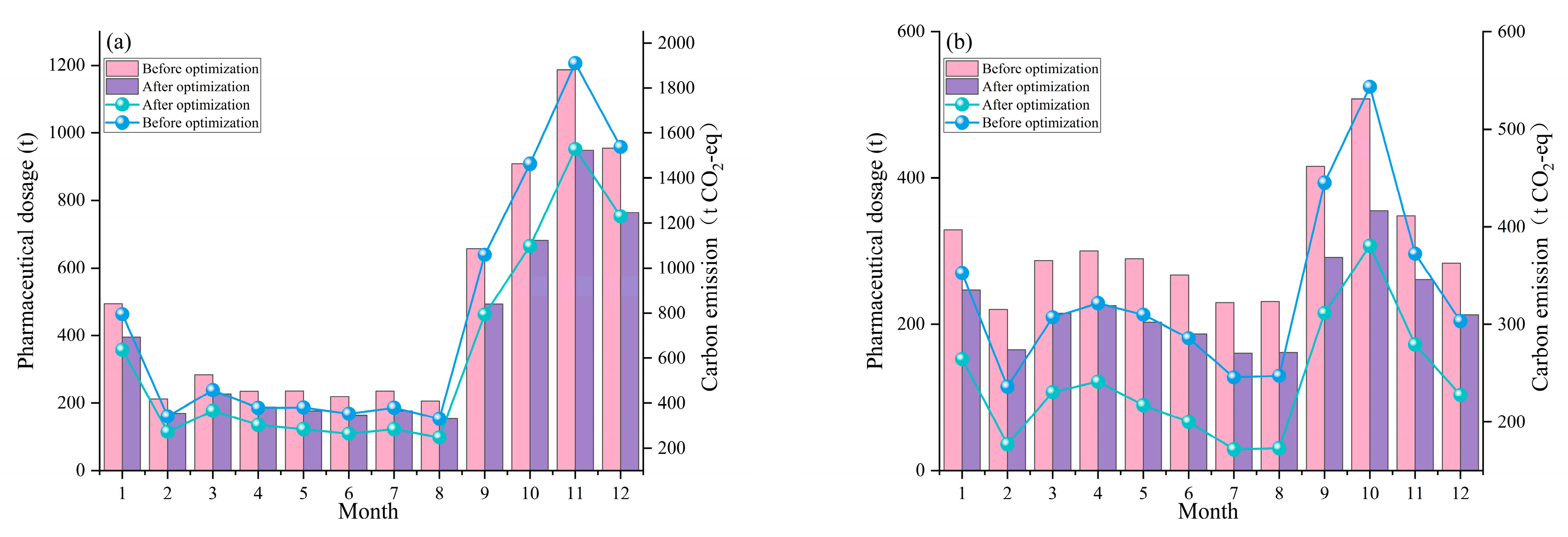Mathematical Modeling and Indirect Carbon Emission Reduction Analysis of Urban Wastewater Treatment Systems Under Different Temperature Conditions
Abstract
1. Introduction
2. Materials and Methods
2.1. Introduction to Sumo
2.2. Modeling of Sewage Treatment Plant
2.3. Model Running Parameter Setting
2.4. Carbon Emission Accounting of Wastewater Treatment Plants
3. Results and Discussion
3.1. Results of Sensitivity Analysis
3.2. Energy Optimization and Carbon Emission Reduction Analysis
3.3. Agent Optimization and Carbon Emission Reduction Analysis
4. Conclusions
Author Contributions
Funding
Data Availability Statement
Acknowledgments
Conflicts of Interest
References
- Yu, Y.; Li, Z.; Yan, Z.; Yuan, H.; Shen, C. Projected Emergence Seasons of Year-Maximum Near-Surface Wind Speed. Geophys. Res. Lett. 2024, 51, e2023GL107543. [Google Scholar] [CrossRef]
- Maslin, M.A.; Lang, J.; Harvey, F. A short history of the successes and failures of the international climate change negotiations. UCL Open Environ. 2023, 5, 8. [Google Scholar] [CrossRef] [PubMed]
- Shen, Y.; Wang, G. Key findings and assessment results of IPCC WGI fifth assessment report. J. Glaciol. Geocryol. 2013, 35, 1068–1076. [Google Scholar]
- Li, W.; Liu, S.; Lu, C. An evaluation concentrated on post-peak carbon trend scenarios designing and carbon neutral pathways in Hebei Province, China. J. Clean. Prod. 2024, 441, 140952. [Google Scholar] [CrossRef]
- Koutsou, O.P.; Gatidou, G.; Stasinakis, A.S. Domestic wastewater management in Greece: Greenhouse gas emissions estimation at country scale. J. Clean. Prod. 2018, 188, 851–859. [Google Scholar] [CrossRef]
- Woon, K.S.; Phuang, Z.X.; Taler, J.; Varbanov, P.S.; Chong, C.T.; Klemes, J.J.; Lee, C.T. Recent advances in urban green energy development towards carbon emissions neutrality. Energy 2023, 267, 126502. [Google Scholar] [CrossRef]
- Li, L.; Wang, X.; Miao, J.; Abulimiti, A.; Jing, X.; Ren, N. Carbon neutrality of wastewater treatment-A systematic concept beyond the plant boundary. Environ. Sci. Ecotechnol. 2022, 11, 100180. [Google Scholar] [CrossRef]
- Karakas, A.; Tozum-Akgul, S.; Komesli, O.T.; Kaplan-Bekaroglu, S.S. Carbon footprint analysis of advanced biological wastewater treatment plant. J. Water Process Eng. 2024, 61, 105254. [Google Scholar] [CrossRef]
- de Jong, H.; Casagranda, S.; Giordano, N.; Cinquemani, E.; Ropers, D.; Geiselmann, J.; Gouzé, J.-L. Mathematical modelling of microbes: Metabolism, gene expression and growth. J. R. Soc. Interface 2017, 14, 20170502. [Google Scholar] [CrossRef]
- Ekama, G.A.; Wentzel, M.C. A predictive model for the reactor inorganic suspended solids concentration in activated sludge systems. Water Res. 2004, 38, 4093–4106. [Google Scholar] [CrossRef]
- Gomez-Brandon, M.; Podmirseg, S.M. Biological waste treatment. Waste Manag. Res. 2013, 31, 773–774. [Google Scholar] [CrossRef] [PubMed]
- McKinney, R.E. Mathematics of complete-mixing activated sludge. J. Sanit. Eng. Div. 1962, 88, 87–113. [Google Scholar] [CrossRef]
- Lawrence, A.W.; McCarty, P.L. Unified basis for biological treatment design and operation. J. Sanit. Eng. Div. 1970, 96, 757–778. [Google Scholar] [CrossRef]
- Gujer, W.; Henze, M.; Mino, T.; van Loosdrecht, M. Activated Sludge Model No. 3. Water Sci. Technol. 1999, 39, 183–193. [Google Scholar] [CrossRef]
- Chen, H.; Wu, J.; Liu, B.; Li, Y.-y.; Yasui, H. Competitive dynamics of anaerobes during long-term biological sulfate reduction process in a UASB reactor. Bioresour. Technol. 2019, 280, 173–182. [Google Scholar] [CrossRef]
- Yasui, H.; Sugimoto, M.; Komatsu, K.; Goel, R.; Li, Y.Y.; Noike, T. An approach for substrate mapping between ASM and ADM1 for sludge digestion. Water Sci. Technol. 2006, 54, 83–92. [Google Scholar] [CrossRef]
- Copp, J.B.; Belia, E.; Snowling, S.; Schraa, O. Anaerobic digestion: A new model for plant-wide wastewater treatment process modelling. Water Sci. Technol. 2005, 52, 1–11. [Google Scholar] [CrossRef][Green Version]
- Liu, B.; Ngo Van, A.; Terashima, M.; Yasui, H. Anaerobic treatment of hydrothermally solubilised sugarcane bagasse and its kinetic modelling. Bioresour. Technol. 2017, 234, 253–263. [Google Scholar] [CrossRef]
- Liwarska-Bizukojc, E.; Biernacki, R.; Gendaszewska, D.; Ledakowicz, S. Improving the operation of the full scale wastewater treatment plant with use of a complex activated sludge model. Environ. Prot. Eng. 2013, 39, 183–195. [Google Scholar]
- Liwarska-Bizukojc, E.; Olejnik, D.; Biernacki, R.; Ledakowicz, S. Calibration of a complex activated sludge model for the full-scale wastewater treatment plant. Bioprocess Biosyst. Eng. 2011, 34, 659–670. [Google Scholar] [CrossRef]
- Kraemer, J.T.; Bagley, D.M. Simulation of the impact of higher ammonia recycle loads caused by upgrading anaerobic sludge digesters. Water Qual. Res. J. Can. 2005, 40, 491–499. [Google Scholar] [CrossRef]
- Sabba, F.; Farmer, M.; Jia, Z.; Di Capua, F.; Dunlap, P.; Barnard, J.; Qin, C.D.; Kozak, J.A.; Wells, G.; Downing, L. Impact of operational strategies on a sidestream enhanced biological phosphorus removal (S2EBPR) reactor in a carbon limited wastewater plant. Sci. Total Environ. 2023, 857, 159280. [Google Scholar] [CrossRef] [PubMed]
- Insel, G.; Yilmaz, G.; Hazi, F.; Artan, N. Model-based evaluation of simultaneous nitrification and denitrification in aerobic granular sludge systems. Environ. Sci. Pollut. Res. 2023, 30, 124780–124789. [Google Scholar] [CrossRef] [PubMed]
- Bisinella, A.B.; Ahmadi, A.; Tiruta-Barna, L.; Sperandio, M. Feasibility of rigorous multi-objective optimization of wastewater management and treatment plants. Chem. Eng. Res. Des. 2016, 115, 394–406. [Google Scholar] [CrossRef]
- Jiang, M.; Zhang, Y.-L.; Zhou, X.-F.; Zhong, Y.-N. Simulation of nitrogen and phosphorus removal in AmOn integrative reactor by activated sludge model 2D. In Proceedings of the 2nd Environment-Enhancing Energy and Biochemicals Conference (EC2SH2012), Shanghai Jiaotong University Minhang Campus, Shanghai, China, 11–13 August 2013; pp. 55–61. [Google Scholar]
- Zhang, X.; Huang, J.; Lin, L.; Liu, S.; Wang, Y.; Zhang, S. A typical case study of the operational performance of municipal wastewater treatment plant in China. Asia-Pac. J. Chem. Eng. 2020, 15, e2476. [Google Scholar] [CrossRef]
- Ruiz, L.M.; Checa, A.; Perez, J.I.; Torre-Marin, J.M.; Munoz-Ubina, A.; Gomez, M.A. Effect of FeCl3 concentration in chemically enhanced primary treatment on the performance of a conventional wastewater treatment plant. A case study. J. Environ. Sci. Health Part A-Toxic/Hazard. Subst. Environ. Eng. 2024, 59, 33–39. [Google Scholar] [CrossRef]
- Piirtola, L.; Hultman, B.; Andersson, C.; Lundeberg, Y. Activated sludge ballasting in batch tests. Water Res. 1999, 33, 1799–1804. [Google Scholar] [CrossRef]
- Insel, G.; Ozyildiz, G.; Okutman-Tas, D.; Guven, D.; Zengin, G.E.; Pala-Ozkok, I.; Kurt, E.S.; Atli, E.; Artan, N.; Takacs, I.; et al. A comprehensive evaluation of process kinetics: A plant-wide approach for nutrient removal and biogas production. Water Res. 2022, 217, 118410. [Google Scholar] [CrossRef]
- Abulimiti, A.; Wang, X.; Kang, J.; Li, L.; Wu, D.; Li, Z.; Piao, Y.; Ren, N. The trade-off between N2O emission and energy saving through aeration control based on dynamic simulation of full-scale WWTP. Water Res. 2022, 223, 118961. [Google Scholar] [CrossRef]
- Li, J.; Jinz, Y.; Guo, Y.; He, J. Enhancement of phosphorus removal in a low temperature A2/O process by anaerobic phosphorus release of activated sludge. Water Sci. Technol. 2013, 67, 2437–2443. [Google Scholar] [CrossRef]
- Helton, J.C.; Davis, F.J. Latin hypercube sampling and the propagation of uncertainty in analyses of complex systems. Reliab. Eng. Syst. Saf. 2003, 81, 23–69. [Google Scholar] [CrossRef]
- Sin, G.; Gernaey, K.V.; Neumann, M.B.; van Loosdrecht, M.C.M.; Gujer, W. Global sensitivity analysis in wastewater treatment plant model applications: Prioritizing sources of uncertainty. Water Res. 2011, 45, 639–651. [Google Scholar] [CrossRef] [PubMed]
- Maktabifard, M.; Al-Hazmi, H.E.; Szulc, P.; Mousavizadegan, M.; Xu, X.; Zaborowska, E.; Li, X.; Mąkinia, J. Net-zero carbon condition in wastewater treatment plants: A systematic review of mitigation strategies and challenges. Renew. Sustain. Energy Rev. 2023, 185, 113638. [Google Scholar] [CrossRef]
- Maktabifard, M.; Awaitey, A.; Merta, E.; Haimi, H.; Zaborowska, E.; Mikola, A.; Mąkinia, J. Comprehensive evaluation of the carbon footprint components of wastewater treatment plants located in the Baltic Sea region. Sci. Total Environ. 2022, 806, 150436. [Google Scholar] [CrossRef] [PubMed]
- IPCC. 2019 Refinement to the 2006 IPCC Guidelines for National Greenhouse Gas Inventories; IPCC: Geneva, Switzerland, 2019.
- China Urban Water Association. Guidelines for Carbon Accounting and Emission Reduction in the Urban Water Sector, 1st ed.; China Architecture Publishing & Media Co., Ltd.: Beijing, China, 2022. [Google Scholar]
- Ozyildiz, G.; Zengin, G.E.; Guven, D.; Cokgor, E.; Ozdemir, O.; Hauduc, H.; Takacs, I.; Insel, G. Restructuring anaerobic hydrolysis kinetics in plant-wide models for accurate prediction of biogas production. Water Res. 2023, 245, 120620. [Google Scholar] [CrossRef] [PubMed]
- Tao, C.; Hamouda, M.A. Steady-state modeling and evaluation of partial nitrification-anammox (PNA) for moving bed biofilm reactor and integrated fixed-film activated sludge processes treating municipal wastewater. J. Water Process Eng. 2019, 31, 100854. [Google Scholar] [CrossRef]
- Zhang, J.; Shao, Y.; Wang, H.; Liu, G.; Qi, L.; Xu, X.; Liu, S. Current operation state of wastewater treatment plants in urban China. Environ. Res. 2021, 195, 110843. [Google Scholar] [CrossRef]
- Mamais, D.; Noutsopoulos, C.; Dimopoulou, A.; Stasinakis, A.; Lekkas, T.D. Wastewater treatment process impact on energy savings and greenhouse gas emissions. Water Sci. Technol. 2015, 71, 303–308. [Google Scholar] [CrossRef]
- Stadler, L.B.; Love, N.G. Impact of microbial physiology and microbial community structure on pharmaceutical fate driven by dissolved oxygen concentration in nitrifying bioreactors. Water Res. 2016, 104, 189–199. [Google Scholar] [CrossRef]
- Boiocchi, R.; Gernaey, K.V.; Sin, G. Understanding N2O formation mechanisms through sensitivity analyses using a plant-wide benchmark simulation model. Chem. Eng. J. 2017, 317, 935–951. [Google Scholar] [CrossRef]
- Piotrowski, R.; Wonia, M.; Wonia, A. Stochastic optimisation algorithm for optimisation of controller parameters for control of dissolved oxygen in wastewater treatment plant. J. Water Process Eng. 2023, 51, 103357. [Google Scholar] [CrossRef]
- Wang, X.; Dong, Y.; Yu, S.; Mu, G.; Qu, H.; Li, Z.; Bian, D. Analysis of the Electricity Consumption in Municipal Wastewater Treatment Plants in Northeast China in Terms of Wastewater Characteristics. Int. J. Environ. Res. Public Health 2022, 19, 14398. [Google Scholar] [CrossRef] [PubMed]
- Gu, Y.; Li, Y.; Li, X.; Luo, P.; Wang, H.; Wang, X.; Wu, J.; Li, F. Energy Self-sufficient Wastewater Treatment Plants: Feasibilities and Challenges. Energy Procedia 2017, 105, 3741–3751. [Google Scholar] [CrossRef]
- Keene, N.A.; Reusser, S.R.; Scarborough, M.J.; Grooms, A.L.; Seib, M.; Santo Domingo, J.; Noguera, D.R. Pilot plant demonstration of stable and efficient high rate biological nutrient removal with low dissolved oxygen conditions. Water Res. 2017, 121, 72–85. [Google Scholar] [CrossRef] [PubMed]
- Zhou, S.; Liu, M.; Chen, B.; Sun, L.; Lu, H. Microbubble- and nanobubble-aeration for upgrading conventional activated sludge process: A review. Bioresour. Technol. 2022, 362, 127826. [Google Scholar] [CrossRef]
- Li, H.; Cheng, X.; Ding, H.; Yang, Y.; Li, D.; Wang, J.; Han, J. Cleaner production and carbon reduction target: Analysis of sewage treatment plants in Nort-Central China. Energy Sources Part A—Recovery Util. Environ. Eff. 2022, 44, 2770–2781. [Google Scholar] [CrossRef]
- Okan, B.; Erguder, T.H.; Aksoy, A. Plant-wide modeling of a metropolitan wastewater treatment plant to reduce energy consumption and carbon footprint. Environ. Sci. Pollut. Res. 2023, 30, 16068–16080. [Google Scholar] [CrossRef]
- Fan, Y.; Bai, Y.; Jiao, W. Estimation of GHG Emissions from Water Reclamation Plants in Beijing. Water Environ. Res. 2016, 88, 795–803. [Google Scholar] [CrossRef]






| Project | Normal Temperature Period Data | Low Temperature Period Data |
|---|---|---|
| Flow Rate (Q) (m3/d) | 127,558.24 | 118,720.82 |
| Total Kjeldahl Nitrogen (TKN) (mg/L) | 30.79 | 32.91 |
| Total Phosphorus (TP) (mg/L) | 3.36 | 3.15 |
| Pondus Hydrogenii (pH) | 7.25 | 7.24 |
| Chemical Oxygen Demand (COD) (mg/L) | 154.11 | 158.22 |
| NH3-N (mg/L) | 21.71 | 20.86 |
| Total Suspended Solids (TSS) (mg/L) | 84.00 | 67.93 |
| Temperature (T) (°C) | 18.00 | 10.00 |
| Parameters | Default | Si,j | Simulated Value at Normal Temperature | Simulated Value at Low Temperature | |||
|---|---|---|---|---|---|---|---|
| COD | BOD | TN | TP | ||||
| Maximum specific growth rate of OHOS | 4 | 0.80 | 0.88 | 1.70 | 1.26 | 1 | 1 |
| Decay rate of OHOS | 0.62 | 1.24 | 1.43 | 1.68 | 1.16 | 0.68 | 0.7 |
| Fermentation growth rate of PAOS | 0.45 | 0.00 | 0.00 | 2.00 | 0.06 | 0.1 | 0.1 |
| Maximum specific growth rate of PAOS under P limited | 0.49 | 0.94 | 0.33 | 1.69 | 0.64 | 0.1 | 0.1 |
| Decay rate of ABOS | 0.17 | 0.76 | 2.00 | 1.75 | 0.86 | 0.25 | 0.12 |
| Half-saturation of O2 for ABOS(AS) | 0.25 | 0.98 | 0.75 | 1.68 | 0.83 | 0.23 | 0.1 |
| Yield of OHOS on readily biodegradable substrate under aerobic conditions | 0.67 | 0.01 | 0.05 | 1.09 | 0.35 | 0.66 | 1 |
| Yield of OHOS on readily biodegradable substrate under anoxic conditions | 0.54 | 0.06 | 0.56 | 2.86 | 0.43 | 0.60 | 0.83 |
| Yield of OHOS on readily biodegradable substrate under anaerobic conditions | 0.1 | 0.01 | 0.12 | 0.37 | 0.64 | 0.14 | 0.14 |
| P content of biomasses | 0.02 | 0.00 | 0.00 | 0.04 | 0.18 | 0.018 | 0.018 |
| Yield on ultimate BOD | 0.95 | 0.00 | 1.00 | 0.00 | 0.00 | 0.6 | 0.3 |
| TP Effluent Value (mg/L) | Different PAC Dosage (%) | ||||||||
|---|---|---|---|---|---|---|---|---|---|
| 60 | 65 | 70 | 75 | 80 | 85 | 90 | 95 | 100 | |
| Normal-temperature period | 0.32 | 0.31 | 0.31 | 0.30 | 0.30 | 0.30 | 0.30 | 0.30 | 0.30 |
| Low-temperature period | 0.29 | 0.28 | 0.27 | 0.27 | 0.26 | 0.26 | 0.26 | 0.26 | 0.26 |
Disclaimer/Publisher’s Note: The statements, opinions and data contained in all publications are solely those of the individual author(s) and contributor(s) and not of MDPI and/or the editor(s). MDPI and/or the editor(s) disclaim responsibility for any injury to people or property resulting from any ideas, methods, instructions or products referred to in the content. |
© 2024 by the authors. Licensee MDPI, Basel, Switzerland. This article is an open access article distributed under the terms and conditions of the Creative Commons Attribution (CC BY) license (https://creativecommons.org/licenses/by/4.0/).
Share and Cite
Liu, S.-Y.; Liang, S.; Chen, Z.-Q.; Ma, Y.-G.; Gao, W.-C.; Tian, X.-Y.; Luo, Y.-Q. Mathematical Modeling and Indirect Carbon Emission Reduction Analysis of Urban Wastewater Treatment Systems Under Different Temperature Conditions. Water 2024, 16, 3039. https://doi.org/10.3390/w16213039
Liu S-Y, Liang S, Chen Z-Q, Ma Y-G, Gao W-C, Tian X-Y, Luo Y-Q. Mathematical Modeling and Indirect Carbon Emission Reduction Analysis of Urban Wastewater Treatment Systems Under Different Temperature Conditions. Water. 2024; 16(21):3039. https://doi.org/10.3390/w16213039
Chicago/Turabian StyleLiu, Shi-Yue, Shuang Liang, Zhi-Qiang Chen, Yong-Guang Ma, Wei-Chun Gao, Xue-Yong Tian, and Yuan-Qing Luo. 2024. "Mathematical Modeling and Indirect Carbon Emission Reduction Analysis of Urban Wastewater Treatment Systems Under Different Temperature Conditions" Water 16, no. 21: 3039. https://doi.org/10.3390/w16213039
APA StyleLiu, S.-Y., Liang, S., Chen, Z.-Q., Ma, Y.-G., Gao, W.-C., Tian, X.-Y., & Luo, Y.-Q. (2024). Mathematical Modeling and Indirect Carbon Emission Reduction Analysis of Urban Wastewater Treatment Systems Under Different Temperature Conditions. Water, 16(21), 3039. https://doi.org/10.3390/w16213039






